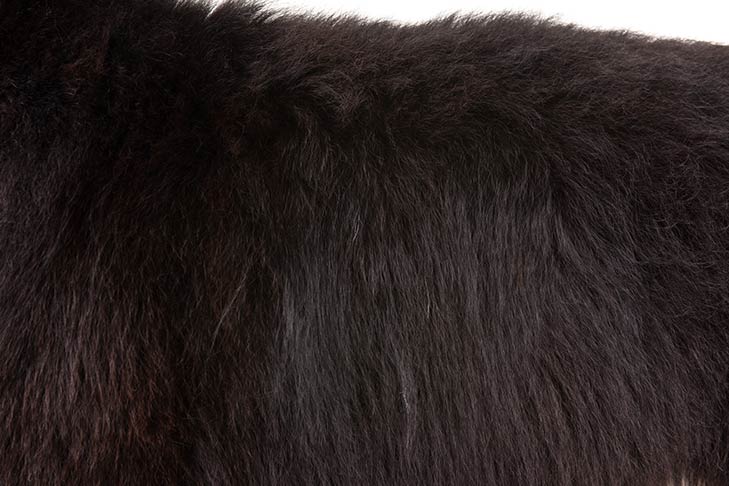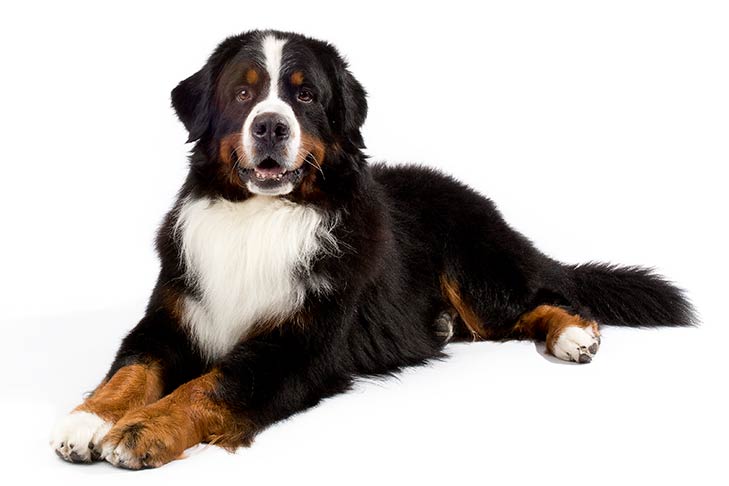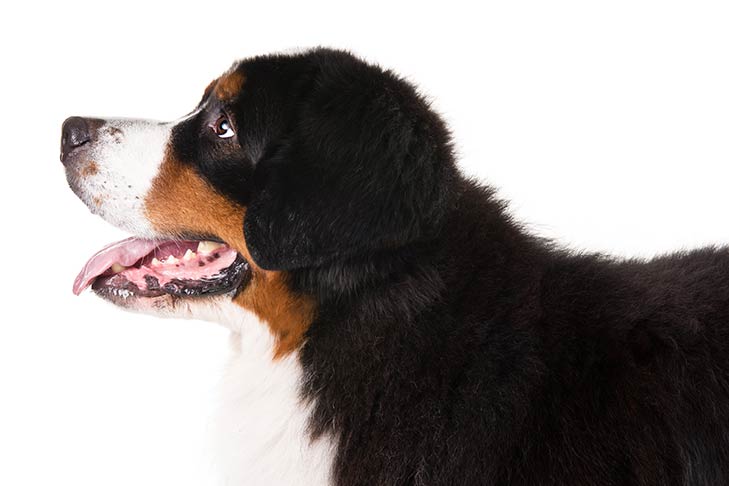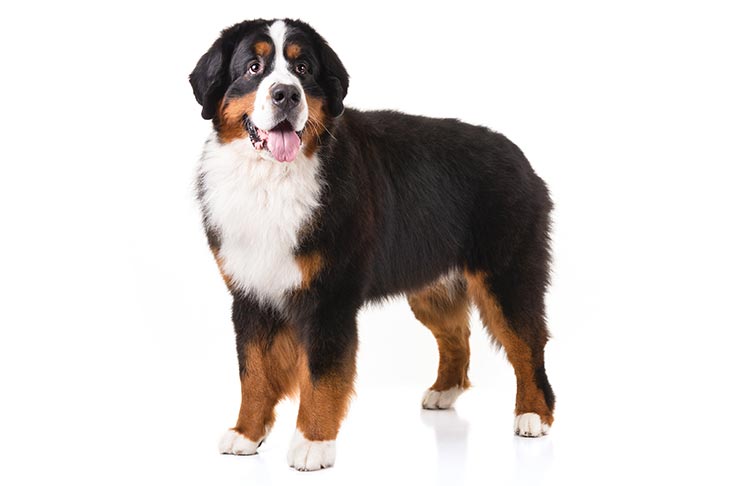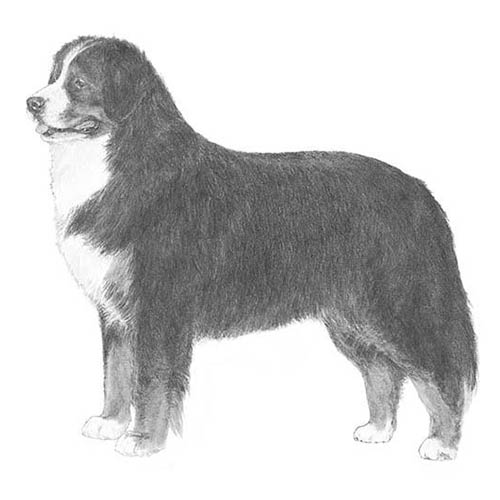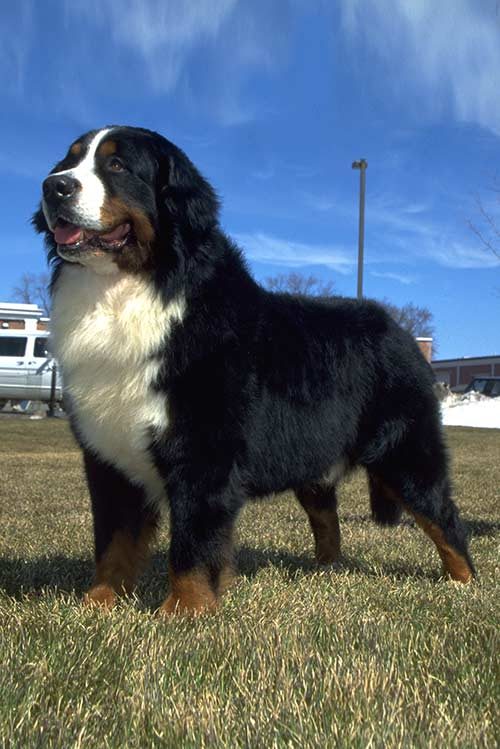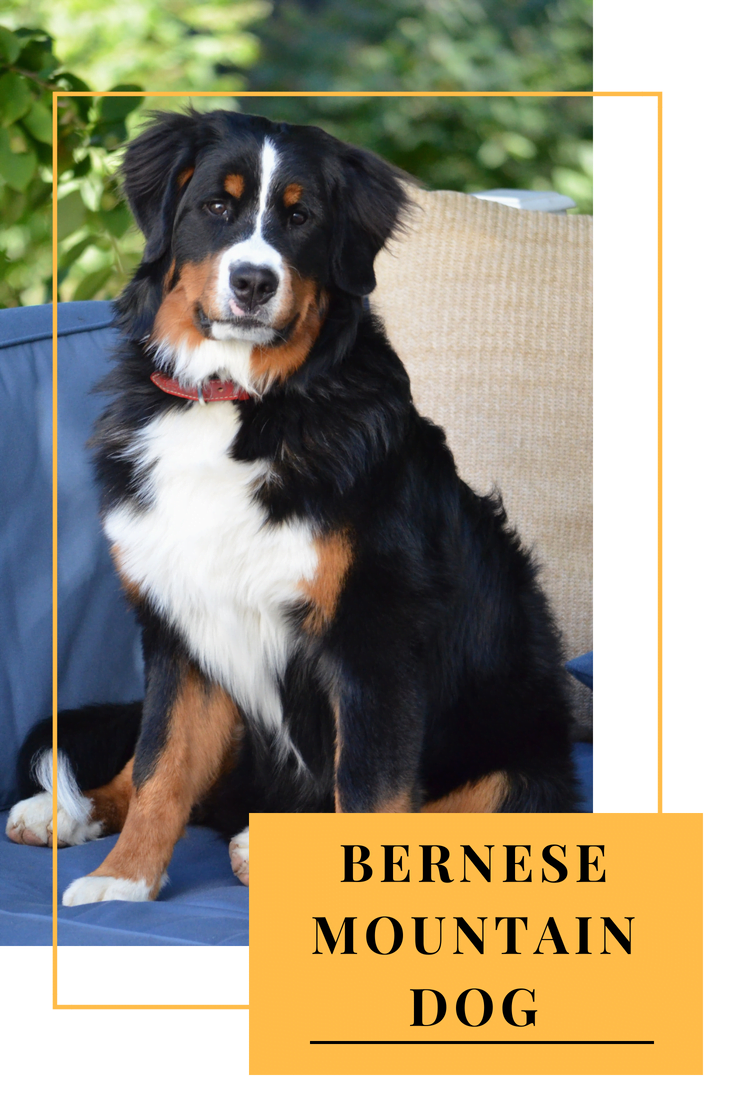The Bernese Mountain Dog is a large, sturdy worker who can stand over 27 inches at the shoulder. The thick, silky, and moderately long coat is tricolored: jet black, clear white, and rust. The distinctive markings on the coat and face are breed hallmarks and, combined with the intelligent gleam in the dark eyes, add to the Berner’s aura of majestic nobility. A hardy dog who thrives in cold weather, the Berner’s brain and brawn helped him multitask on the farms and pastures of Switzerland.
Berners get along with the entire family and are particularly gentle with children, but they will often become more attached to one lucky human. Berners are imposing but not threatening, and they maintain an aloof dignity with strangers.
Big, powerful, and built for hard work, the Bernese Mountain Dog is also strikingly beautiful and blessed with a sweet, affectionate nature. Berners are generally placid but are always up for a romp with the owner, whom they live to please.
The Breed Standard
GENERAL APPEARANCE
The Bernese Mountain Dog is a striking. tri-colored, large dog. He is sturdy and balanced. He is intelligent, strong and agile enough to do the draft and droving work for which he was used in the mountainous regions of his origin. Male dogs appear masculine, while bitches are distinctly feminine.
HEAD
Expression is intelligent, animated and gentle. The eyes are dark brown and slightly oval in shape with close-fitting eyelids. Inverted or everted eyelids are serious faults. Blue eye color is a disqualification. The ears are medium sized, set high, triangular in shape, gently rounded at the tip, and hang close to the head when in repose. When the Bernese Mountain Dog is alert, the ears are brought forward and raised at the base; the top of the ear is level with the top of the skull. The skull is flat on top and broad, with a slight furrow and a well-defined, but not exaggerated stop. The muzzle is strong and straight. The nose is always black. The lips are clean and, as the Bernese Mountain Dog is a dry-mouthed breed, the flews are only slightly developed. The teeth meet in a scissors bite. An overshot or undershot bite is a serious fault. Dentition is complete.
NECK, TOPLINE, BODY
The neck is strong, muscular and of medium length. The topline is level from the withers to the croup. The chest is deep and capacious with well-sprung, but not barrel-shaped, ribs and brisket reaching at least to the elbows. The back is broad and firm. The loin is strong. The croup is broad and smoothly rounded to the tail insertion. The tail is bushy. It should be carried low when in repose. An upward swirl is permissible when the dog is alert, but the tail may never curl or be carried over the back. The bones in the tail should feel straight and should reach to the hock joint or below. A kink in the tail is a fault.
FOREQUARTERS
The shoulders are moderately laid back, flat-lying, well-muscled and never loose. The legs are straight and strong and the elbows are well under the shoulder when the dog is standing. The pasterns slope very slightly, but are never weak. Dewclaws may be removed. The feet are round and compact with well-arched toes.
HINDQUARTERS
The thighs are broad, strong and muscular. The stifles are moderately bent and taper smoothly into the hocks. The hocks are well let down and straight as viewed from the rear. Dewclaws should be removed. Feet are compact and turn neither in nor out.
COAT
The coat is thick, moderately long and slightly wavy or straight. It has a bright natural sheen. Extremely curly or extremely dull-looking coats are undesirable. The Bernese Mountain Dog is shown in natural coat and undue trimming is to be discouraged.
Care
Nutrition
The Bernese Mountain Dog should do well on high-quality dog food, whether commercially manufactured or home-prepared with your veterinarian’s supervision and approval. Any diet should be appropriate to the dog’s age (puppy, adult, or senior). Some dogs are prone to getting overweight, so watch your dog’s calorie consumption and weight level. Treats can be an important aid in training, but giving too many can cause obesity. Learn about which human foods are safe for dogs, and which are not. Check with your vet if you have any concerns about your dog’s weight or diet. Clean, fresh water should be available at all times.
Grooming
The Bernese Mountain Dog has a double coat, with a longer outer coat and a wooly undercoat. Berners shed a fair amount, even more so during shedding season, which occurs twice a year. Weekly brushing—daily during shedding season—will help to remove loose hair and keep the dog looking his best. Any tangles can be worked out with a slicker brush or metal comb. As with all breeds, the nails should be trimmed regularly, as overly long nails can cause the dog pain and structural problems.
Exercise
Bernese Mountain Dogs need at least a half-hour of moderate exercise every day to stay healthy and happy. While they are definitely meant to live indoors with their human family, Berners enjoy outdoor activities and make great companions on long walks or hikes. Outdoorsy owners often take their canine companions camping and backpacking. Berners enjoy pulling young children in a cart, and some even participate in carting and drafting competitions. Other canine sports in which Berners participate and excel include agility, herding, obedience, rally, and tracking.
Training
Early socialization and obedience training are important for all dogs, but especially so for breeds as large as the Bernese Mountain Dog. Berners are intelligent and eager to please, so they are usually easy to train. They are also affectionate and openhearted; their feelings are easily hurt, and so they don’t respond well to harsh corrections or training methods. A Berner wants to be with his family, and undesirable behaviors can result if he is regularly left alone for long periods of time.
Health
Berners are generally healthy dogs, and responsible breeders will screen their breeding stock for health conditions such as hip and elbow dysplasia, blood disorders, some cancers, and progressive retinal atrophy. All large breeds are susceptible to bloat, a sudden, life-threatening stomach condition. Berner owners should learn what signs to look out for, and what to do should they occur. As with all breeds, a Berner’s ears should be checked regularly for signs of infection, and the teeth should be brushed often, using a toothpaste designed for dogs.
Recommended Health Tests from the National Breed Club:
- Hip Evaluation
- Elbow Evaluation
- Ophthalmologist Evaluation
- Cardiac Exam
- Von Willebrand’s Disease DNA Test
History
The Bernese Mountain Dog is one of four mountain-dog breeds who were long at home in the canton of Bern, a vast agricultural region vital to the dairy production required for two of Switzerland’s most profitable exports: chocolate and cheese. Even today, Bern’s website tells us, “Over 12,000 farms are spread over the canton’s valleys, hills, and mountain areas.”
Berners earned their keep by droving cattle, guarding farmyards from predators, and serving as gentle companions when the hard work of the day was done. Perhaps their greatest claim to working-dog fame is their ability to pull many times their own weight as drafting dogs, with their broad and muscular hindquarters generating immense strength.
Despite the breed’s great utility in the days before mechanized farming and ranching, by the late 1800s the Berner’s numbers were dwindling and the quality of the surviving dogs left something to be desired. A painstaking effort was begun by Swiss fanciers to reverse the breed’s decline.
In 1907, a Swiss breed club was formed under the leadership of Professor Albert Heim, perhaps the most respected European dog man of his generation. Before long, Berners were once again a favored farm dog, and they also caught on as companions with Swiss householders.
The breed’s American history began in 1926, when a Kansas farmer imported a pair as all-around farm dogs. They caught on quickly, and the AKC registered its first Berner in 1937. Today, the Bernese Mountain Dog Club of America sponsors drafting and carting events that test the working ability of these majestic mountaineers.
Did You Know?
It was not until 1892 that the Swiss fancier Franz Schertenleib attempted to find good specimens to be used as breeding stock.
The Bernese is one of four varieties of Swiss Mountain Dog.
The Bernese shares similar distinctive coloring with the other varieties of Swiss Mountain Dog, but it is the only one of the four to have a long, silky coat.
The Bernese is known in native land as Berner Sennenhund.
The Bernese worked as drovers and draft dogs as well as watchdogs in the farmyards, mainly in the canton of Berne, Switzerland.
Recent Pet Posts
Blog Categories
Product categories
- Accessories (7)
- Chicken & Veggie Wraps (8)
- Grillers Jerky Tenders (4)
- Jerky Treats (10)
- Made in the USA (9)
- Non-Rawhide Treats (28)
- Beggar Bone (11)
- Bully Sticks (4)
- Butcher Bone (4)
- Cod Skin Fish Treats (3)
- Pork Skin Twists (2)
- Pressed Rawhide Bones & Rolls (16)
- Bones & Rolls (6)
- Pressed Rawhide Bulk (6)
- Twist Sticks (4)
- Savory Munchies (13)
- Supreme Bones & Rolls (48)
- American Rawhide Bulk (16)
- Rawhide Bones (14)
- Rawhide Chips (6)
- Rawhide Rolls & Sticks (12)
- Uncategorized (8)

